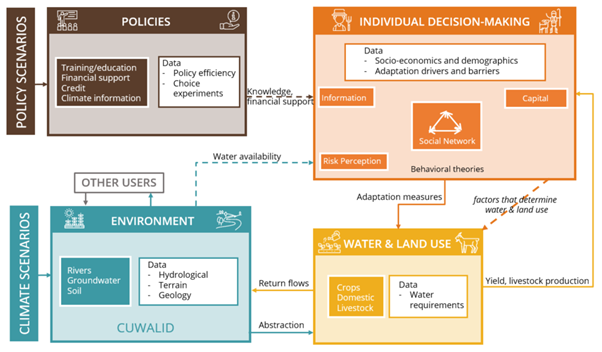Designing an Agent-Based Model (ABM)
Introduction to Agent-Based Models by DOWN2EARTH Team Members, Ileen Streefkerk and Teun Schrieks
At IVM-VU Amsterdam we are developing an agent-based model to analyze the interactions and feedbacks between climatic stressors, human behavior and policy implementations in the three selected regions in Kenya, Ethiopia and Somaliland. Agent-based modelling is a type of computational modelling for simulations of actions and interactions of autonomous individuals (agents), which can capture the dynamic feedbacks between heterogeneous individuals and their environment. The central agent in our model will be the agro-pastoralists in the local communities of our case study regions. Our model will consist of four components: Individual decision-making, water & land use, the environment and policies. In the individual decision-making component, we develop decision rules to simulate decision-making related to water and land use and adaptation to climate change. The decisions in the individual decision-making component feed into the water & land use component which simulates the water requirements for crops, livestock and domestic water use.

The water & land use and individual-decision making components will be coupled to the Climate into Useful Water And Land Information in Drylands (CUWALID) model. This hydrological model, developed by our colleagues at Cardiff University, can simulate the water availability of the selected catchments by capturing relevant hydrological processes of dryland regions specifically. Information on water availability, from the CUWALID model, feeds into the decision-making component and influences the behavior of the agro-pastoralists. These changes in decision-making feed back into the CUWALID model through the water & land use component, such that we can simulate dynamic interactions between human behavior and the environment. Finally, we will include the policy component. Based on the policy analysis of the policy development team and the data collection of the end-user-engagement-impact team we will define policy scenarios and the impact of policies in the local communities, which feeds into the individual decision-making component. The aim of our final model is to simulate the influence of different policy scenarios on the feedbacks between humans and their environment under different climate change scenarios.
A challenge of agent-based modelling is that it requires several different types of empirical data to make sure that the model gives a realistic representation of reality. In the first stage of model development we develop a conceptual model which we aim to finish in autumn this year (2021). For this conceptual model we need to select the main agent types and parameters. This requires qualitative information on, among others, the main livelihoods in the local communities, the type of water and land use decisions, the main adaptation drivers and barriers and communication within communities and their social network and with the relevant government officials and NGOs in their region. The qualitative information will be gathered in the first stage of field work of the end-user-engagement-impact team. In a later stage of model development we need to calibrate and validate the model parameters, which requires more data on socio-economic and demographic characteristics, drivers of human behavior and the interaction between humans, water availability/climate stressors and policymakers. This information will be gathered in the second stage of data collection, through interviews and choice-experiments or economic field experiments in the local communities and interviews with local policymakers and NGOs.
